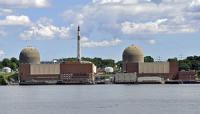-
Low-cost imaging system detects natural gas leaks in real time
Researchers have developed an infrared imaging system that could one day offer low-cost, real-time detection of methane gas leaks in pipelines and at oil and gas facilities. Leaks of methane, the primary component of natural gas, can be costly and dangerous while also contributing to climate change as a greenhouse gas. Infrared device enables reliable monitoring under a range of environmental conditions.
-
-
A new kind of responder brings special expertise to disasters
An emergency response incident commander should be well-versed on how to respond to all hazards, including the intricacies of radiological and nuclear incidents. Because the hazards associated with radiological or nuclear (rad/nuc) incidents are uniquely challenging to convey accurately to first responders, DHS S&T has developed a solution in the form of the Radiological Operations Support Specialist (ROSS) Program.
-
-
New technique could lead to more efficient, safer uranium extraction
The separation of uranium, a key part of the nuclear fuel cycle, could potentially be done more safely and efficiently through a new technique developed by chemistry researchers at Oregon State University. The technique uses soap-like chemicals known as surfactants to extract uranium from an aqueous solution into a kerosene solution in the form of hollow clusters. Aside from fuel preparation, it may also find value in legacy waste treatment and for the cleanup of environmental contamination.
-
-
NY’s Indian Point nuclear plant to close after many “safety events”

New York’s Indian Point nuclear power plant will close by April 2021, Governor Andrew Cuomo said on Monday. “For fifteen years, I have been deeply concerned by the continuing safety violations at Indian Point, especially given its location in the largest and most densely populated metropolitan region in the country,” Cuomo said. “I am proud to have secured this agreement with Entergy [the plant’s operator] to responsibly close the facility fourteen years ahead of schedule, to protect the safety of all New Yorkers.”
-
-
Israel’s coming chemical weapons crisis
One of the more iconic and sobering elements of Israeli reality were the gas masks distributed on the street or at post offices to every citizen after Saddam Hussein fired SCUD missiles at Israel during the 1991 Gulf War. They continued to be distributed until early 2014, when the Israeli government decided to end the practice in the wake of an international deal to disarm Syria of its chemical weapons stockpiles. Now, nearly three years later, the issue has resurfaced as a direct result of the Syrian civil war—in particular, the threat from both Hezbollah and the Islamic State.
-
-
Chemistry research breakthrough could improve nuclear waste recycling technologies
Researchers have taken a major step forward by describing the quantitative modelling of the electronic structure of a family of uranium nitride compounds – a process that could in the future help with nuclear waste recycling technologies. “In this nuclear age, there is a pressing need for improved extraction agents for nuclear waste separations and recycling technologies,” explained one of the researchers.
-
-
Biological emergences: Incremental progress not enough
While acknowledging some positive efforts over the past year by the White House and Congress, the bipartisan Blue Ribbon Study Panel on Biodefense says the incremental progress is not enough to defend against biological emergencies, let alone catastrophic events. The report, Biodefense Indicators – One Year Later, Events Outpacing Federal Efforts to Defend the Nation, states that while the biological threat is real and continues to grow, our nation remains woefully under-prepared for dangerous biological incidents.
-
-
Syrian opposition: Israeli airstrike hit chemical weapons intended for Hezbollah

An Israeli air raid on a depot controlled by the Syrian regime two weeks ago hit a supply of chemical weapons being transferred to the Iran-backed terror group Hezbollah, a spokesperson for a Syrian opposition group said Sunday. Israeli Defense Minister Avigdor Liberman obliquely suggested last week that Israel was responsible for the strike and that the target had been Hezbollah-bound chemical weapons; other Israeli leaders have made it clear in public statements and conversations with foreign leaders that they will act to prevent Hezbollah from acquiring “game-changing” weapons or strengthening its positions on Israel’s borders.
-
-
Israeli defense minister suggests Hezbollah was smuggling chemical weapons
Israel is working hard to keep chemical weapons out of the hands of the Iran-backed terror group Hezbollah, Israeli Defense Minister Avigdor Liberman told a Knesset committee Thursday. His comments to the Knesset seemed to suggest that at least one of the strikes Israel carried out the same day at the Mazzeh military airport near Damascus was in order to stop Hezbollah from acquiring chemical weapons.
-
-
$19 million to develop drugs to treat victims of chemical weapons attacks
First used by the German military against Allied troops in the First World War and in subsequent wars including the Iran-Iraq conflict during the 1980s, chemical weapons were more recently used by the Assad regime in Syria and by ISIS in Iraq and Syria. The National Institutes of Health (NIH) has awarded Rutgers University a five-year grant for more than $19 million for research that would lead to the development of drugs to treat toxicity from chemical agents used in a terrorist attack.
-
-
Improve trace detection of explosives by sniffing like a dog
By mimicking how dogs get their whiffs, a team of government and university researchers have demonstrated that “active sniffing” can improve by more than ten times the performance of current technologies that rely on continuous suction to detect trace amounts of explosives and other contraband.
-
-
Former IAEA deputy director criticizes nuclear agency’s Iran investigations
Olli Heinonen, the former deputy director-general of the International Atomic Energy Agency has criticized the agency for “reduc[ing] the level of transparency and details in its reporting” on Iran’s nuclear program, making it “practically impossible” to confirm that Iran is complying with the terms of the nuclear deal.
-
-
Sandia’s radiation security team helps protect the public in large events
Sandia National Laboratories’ Radiological Assistance Program (RAP) team is one of several Department of Energy (DOE)/National Nuclear Security Administration (NNSA) teams in nine U.S. regions. The teams provide radiological detection support for large public events in Kansas, Oklahoma, Texas, New Mexico, and Arizona. They also help with major public events around the United States, such as Super Bowls or visits from the pope.
-
-
Exercising the U.S. nuclear forensics capabilities
The Domestic Nuclear Detection Office (DNDO) plays an important role in the field of nuclear forensics. In addition to advancing technical capabilities and supporting expertise development, DNDO coordinates with other partners to exercise the U.S. government’s ability to collect nuclear debris samples in the event of a detonation and transport them to laboratories for analysis.
-
-
Bathroom air freshener triggers emergency response at nuclear weapons complex
Late in the afternoon on Wednesday of last week officials at the nuclear weapons complex declared an emergency after finding what they regarded as a suspicious device in a bathroom at the Savannah River National Laboratory in South Carolina. Emergency teams determined that the suspicious device was an air freshener wrapped in paper towels with a flashing light on it.
-
More headlines
The long view
Keeping the Lights on with Nuclear Waste: Radiochemistry Transforms Nuclear Waste into Strategic Materials
How UNLV radiochemistry is pioneering the future of energy in the Southwest by salvaging strategic materials from nuclear dumps –and making it safe.
Model Predicts Long-Term Effects of Nuclear Waste on Underground Disposal Systems
The simulations matched results from an underground lab experiment in Switzerland, suggesting modeling could be used to validate the safety of nuclear disposal sites.
